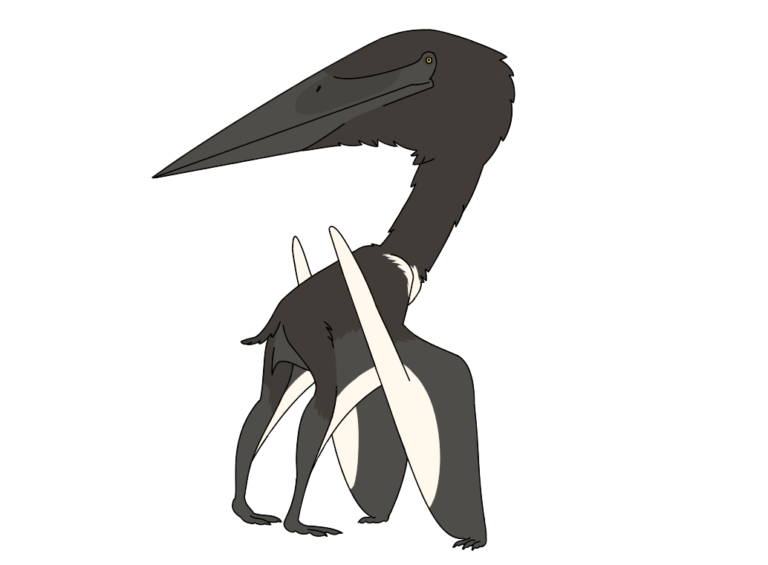
Radiodactylus langstoni was a pterosaur that lived near what is now Dinosaur Valley State Park during the early Cretaceous.
The one and only bone we have from Radiodactylus, a humerus, was found during construction at the Comanche Peak Nuclear Powerplant. Hence the Radio—as in radioactive.
One measly wing bone may not seem like a lot to go on. Pterosaur bones, like bird bones, are mostly hollow, so many are destroyed before they have a chance to fossilize. Luckily, paleontologists have learned to make the most of these rare finds.
For starters, the special shape of the wing bone tells us that Radiodactylus was probably related to a group of pterosaurs called Azhdarchids. Azhdarchids were flying reptiles with crazy-big heads and long, toothless beaks. From preserved tracks, we can tell they moved on all fours, had soft footpads, and walked with narrow strides. Some species’ necks were very long, but instead of curving like a swan’s, they probably stayed stiff and straight.
Like all pterosaurs, Radiodactylus most likely had pycnofibers, a unique kind of reptile fuzz, on its body and wings. Some pycnofibers grew in single strands like fur, while others grew in tufts like bird down. A recent study of Tupandactylus, a pterosaur from the same time period as Radiodactylus, revealed pycnofibers of several different colors—though scientists aren’t yet clear on which colors, exactly. This means that some pterosaurs were multicolored.
To get a good idea of how big Radiodactylus might’ve been, I reached out to Dr. Dale Winkler who works at SMU and has written several papers about Cretaceous animals in Texas. By comparing Radiodactylus’ humerus (SMU 72547) to other Azhdarchids’ bones, Dr. Winkler estimated that Radiodactylus had a wingspan of about ten feet. That’s competitive with some of our largest modern birds!
Looking at Azhdarchids’ lanky legs and spear beaks, it’s easy to imagine them wading in shallows and catching fish like modern herons. But the more we learn, the more it seems that Azhdarchids did best on dry land. For one thing, their little feet would sink in mud or wet sand. For another, their footpads are perfect cushions for walking on firm ground. Many Azhdarchid bones are also found inland, where their narrow stance and tall bodies would make it easy to travel through, and see over, messy undergrowth.
It’s most likely that Radiodactylus spent its time patrolling the forests and dry shore of the Western Interior Seaway, scanning for meaty snacks.
Radiodactylus’ debut paper:
An amazing breakdown of Azhdarchid bodies and behavior:
Witton MP, Naish D (2008) A Reappraisal of Azhdarchid Pterosaur Functional Morphology and Paleoecology. PLOS ONE 3(5): e2271. https://doi.org/10.1371/journal.pone.0002271
An article about the Tupandactylus pycnofiber study:
Pterosaurs May Have Had Brightly Colored Feathers, Exquisite Fossil Reveals – Scientific American
Special thanks to Dr. Dale Winkler for estimating Radiodactylus’ wingspan, and for writing so many of the research papers that Cecelia and the Living Fossils depends on!
meet radiodactylus
Radiodactylus langstoni appears in Chapters 1, 2, and 3 of Cecelia and the Living Fossils.
Teenage necromancer + dinosaur bones. What could go wrong? See for yourself.

Really cool! Thanks Katie!
I’m glad you liked it!